Perceptions of drugs
While a majority of questions in the National Drug Strategy Household Survey relate to the use of drugs (both licit and illicit) in Australia, there are also several questions about how people in Australia think about drugs, which drugs they are most concerned about, and their level of approval or disapproval of the use of those drugs.
These results are important as they reflect the views of people in Australia, and may indicate areas where additional policy efforts or education may need to be developed.
People’s views of drugs are likely to be impacted by their personal experiences with drugs, use of drugs by friends and family members, media coverage and local community concerns.
What drugs do people think of when hearing about ‘a drug problem’?
When hearing the term ‘a drug problem’, 2 in 5 people (42%) first thought about methamphetamine and amphetamine (also called speed, meth or ice), making it the most commonly thought of drug (Figure 1). The next most commonly selected drug was marijuana/cannabis (12.9%), and for the first time in 2022–2023 cocaine was the third-most commonly chosen drug, with more people thinking of it (12.3%) than heroin (11.4%).
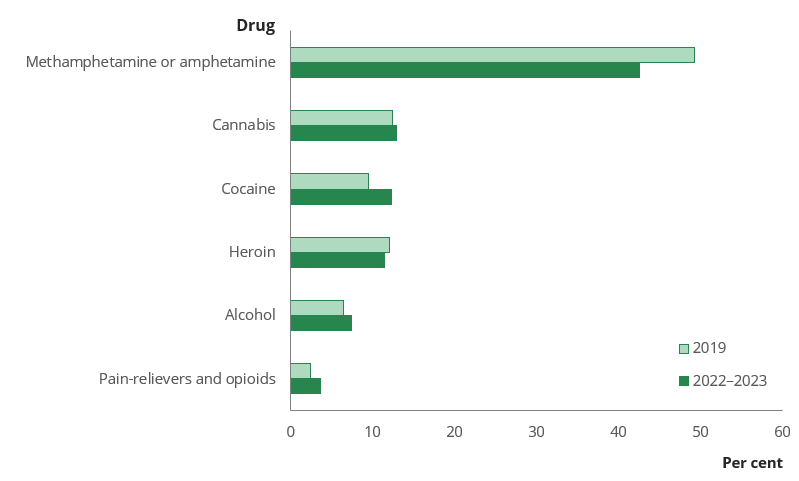
Note Prior to 2022–2023, ‘Methamphetamine or amphetamine’ was called ‘Meth/amphetamines’.
Note: Respondents could only select one drug.
Source: NDSHS 2022–2023, Table 11.1.
Cocaine was not the only drug that showed a considerable change between 2019 and 2022–2023. While still the most common, people were less likely to nominate methamphetamine or amphetamine as the drug most likely to be associated with ‘a drug problem’, dropping from 49% in 2019 to 42% in 2022–2023.
In contrast, people in 2022–2023 were more likely to nominate alcohol (increasing from 6.4% in 2019 to 7.4% in 2022–2023) and pain-relievers and opioids (from 2.4% to 3.6%) as the first drug they thought of when considering ‘a drug problem’.
Different generations have different ideas of ‘a drug problem’
Generally, young people were more likely than older people to think of cocaine as the drug involved in ‘a drug problem’, particularly people aged 14–17 (26%). In contrast, just 8.4% of people in their 60s thought of cocaine. The same pattern occurred for marijuana/cannabis, which was the drug most often nominated by people aged 14–17 (28%).
Those in their 50s (51%) and 60s (46%) were more likely to identify methamphetamine and amphetamine as the drug involved in ‘a drug problem’, and were also more likely to nominate heroin than younger people (Figure 2).
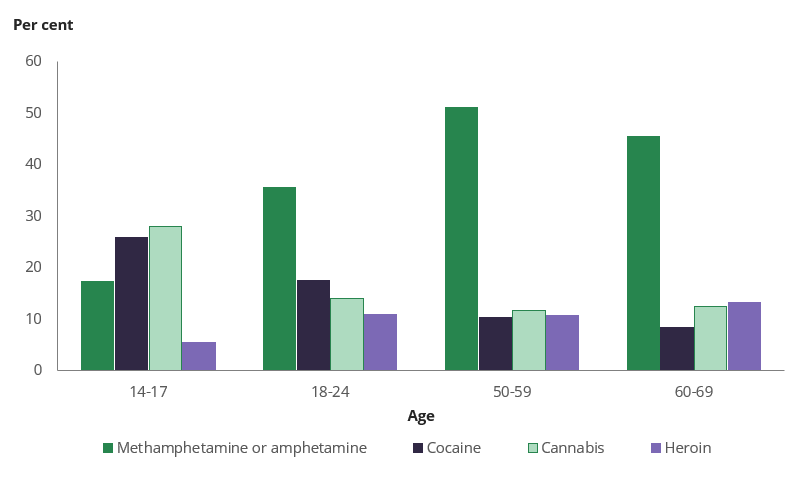
Source: NDSHS 2022–2023, Table 11.2.
People believe alcohol causes the most deaths in Australia
Historically, tobacco has contributed to more deaths in Australia than alcohol and illicit drug use combined (AIHW, 2021). Despite this, in 2022–2023 more people thought alcohol caused the most deaths in Australia (39%), followed by tobacco (17.4%), methamphetamine and amphetamine (14.8%) and pain-killers/pain-relievers and opioids (6.7%, Figure 3).
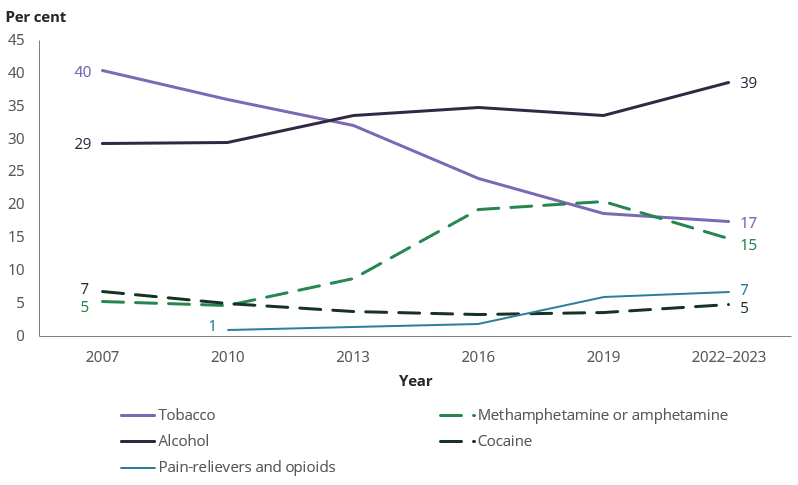
Source: NDSHS 2022–2023, Table 11.3.
The proportion of people nominating tobacco as the drug responsible for the most deaths continued the decline occurring since 2007, when it was the most nominated drug (40%). Over the same period, people became more likely to choose alcohol, which increased from 29% to 39%, and pain-relievers and opioids which increased more than seven-fold between 2010 (0.9%) and 2022–2023 (6.7%).
The proportion of people who thought methamphetamine or amphetamine caused the most deaths in Australia decreased from 20% in 2019 to 14.8% in 2022–2023, reversing the increasing trend occurring since 2010 (Figure 3).
People are most concerned about methamphetamine and amphetamine, but concern about alcohol is on the rise
The National Drug Strategy Household Survey asks people which form of drug use they believe is of the most serious concern for the general community, reflecting the drugs that they believe may cause the most harm in society.
In 2022–2023, people were most likely to select methamphetamine or amphetamine use as the most serious concern for the community, reflecting its nomination as the most likely drug to be involved in ‘a drug problem’. However, concern about methamphetamine and amphetamine use in the community has declined since 2019, from 40% to 35% in 2022–2023.
In contrast, concern about excessive drinking of alcohol increased from 26% in 2019 to 31% in 2022–2023 (Figure 4).
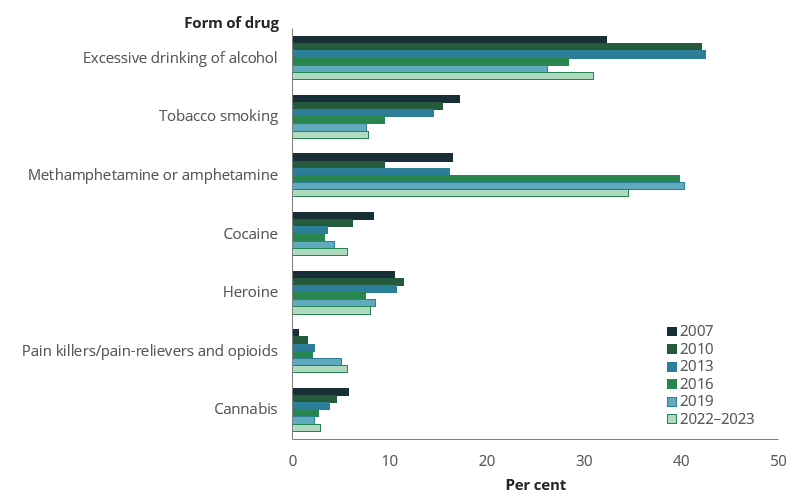
Source: NDSHS 2022–2023, Table 11.5.
Other notable changes in concern in 2022–2023 included:
- In 2022–2023, 5.6% of people were most concerned about the non-medical use of pain-killers/pain-relievers and opioids, nearly 10 times the proportion in 2007 (0.6%).
- Despite marijuana/cannabis remaining the most used illicit drug in 2022–2023, only 2.8% of people considered it to be the drug of most concern to the general community (up from 2.2% in 2019).
Despite growing concern, people were less supportive of policies designed to reduce the problems associated with excessive alcohol use
In 2022–2023 alcohol was the drug that the most people thought was responsible for the greatest number deaths in Australia, more than double the next-most selected drug (tobacco). Additionally, 31% of people believed that excessive drinking of alcohol was the greatest concern for the general community, up from 26% in 2019.
However, when asked about policies aimed at reducing the problems associated with excessive alcohol use, support for a majority of policies declined between 2019 and 2022–2023, continuing a trend in reduced support for alcohol-related policies occurring since 2013. More than half of the suggested policies showed an increase in opposition between 2019 and 2022–2023, with the biggest changes being:
- Raising the legal drinking age (36% opposed in 2019, 41% in 2022–2023)
- Reducing trading hours for all pubs and clubs (40% to 43%)
- Strict monitoring of late-night licensed premises (10.3% to 12.2%).
Most people do not approve of regular drug use, but approval did increase for several drugs
In 2022–2023, most people did not approve of the regular use of any drug. As in 2019, people were most likely to approve of an adult regularly using alcohol (46%), and more people approved of the regular use of cannabis (23%) than tobacco (15.5%).
Also similar to 2019, disapproval was highest for the regular use of heroin (95% of people disapproved), sniffing petrol/glue/aerosols/solvents (95%) and methamphetamine and amphetamine (93%) in 2022–2023.
Between 2019 and 2022–2023 the approval for all drugs remained low, and was either stable or increased marginally. In general, approval of the regular use for a number of drugs has been gradually increasing, and was at the highest seen since the beginning of time-series reporting in 2007:
- Cannabis increased from 6.6% in 2007 to 23% in 2022–2023.
- Hallucinogens increased from 1.7% to 9.5%.
- Kava increased from 4.3% to 8.6%.
- Ecstasy increased from 2.0% to 4.8%.
- Non-medical use of steroids increased from 1.6% to 3.5%.
- Ketamine increased from 1.0% to 3.4%.
- Despite being the second-most commonly used illegal drug in 2022–2023, approval of the regular use of cocaine/crack showed only a small increase, from 1.4% in 2007 to 2.8% in 2022–2023.
These changes reflect a small but growing acceptance towards the use of some drugs in Australia, and were mirrored by small increases in the proportion of people who supported legalisation of all five included illicit drugs, and decreases in the proportion of people who believe sale or supply of those drugs should have increased penalties (Figure 5).
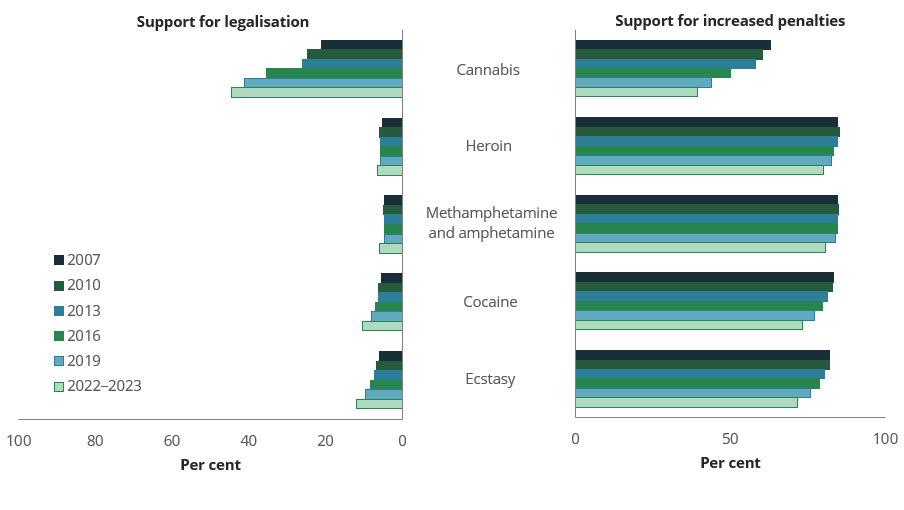
Source: NDSHS 2022–2023, Tables 11.23 and 11.27.


